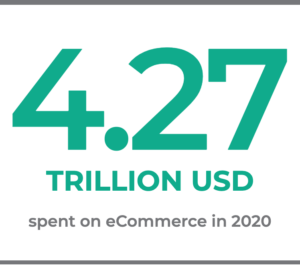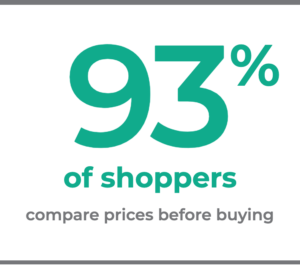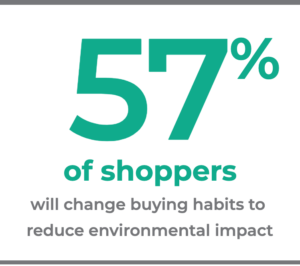With added growth, comes added competition. And the recent growth in online shopping means companies need to increase eCommerce sales and stay competitive.
The Growing eCommerce Market
 USD 4.27 trillion was spent on eCommerce worldwide in 2020. That number is forecast to reach USD 5.4 trillion in 2022.1 Those dollars came from more than 3.4 billion people shopping online in 2020.2 By 2025, it’s forecast that 4.9 billion people will shop online globally.2
USD 4.27 trillion was spent on eCommerce worldwide in 2020. That number is forecast to reach USD 5.4 trillion in 2022.1 Those dollars came from more than 3.4 billion people shopping online in 2020.2 By 2025, it’s forecast that 4.9 billion people will shop online globally.2
While 77% of shoppers shopped at a brick-and-mortar store before COVID, only 43% did during the pandemic. And just 54% say they’ll go back to shopping in person more often than online after COVID is over.3
The big caveat to all of those glowing statistics? More companies are competing for — and will continue to compete for — those dollars than ever before.
Increasing eCommerce Competition
A statement from Deloitte sums up the current eCommerce landscape perfectly. “E-commerce players seeing a surge in volume will do everything in their power to retain their newly acquired customers through loyalty programs, subscription models, promotions, and expansion of the product range. The competition intensifies with consumers using price engines and referral sites to find the best deals online.”4
So what can eCommerce companies do to capture or — at least keep — part of the eCommerce pie?
Meet — or Exceed — Your Customers Expectations by Understanding What They Want
Customers, including eCommerce customers, expect a lot. A good way to increase eCommerce sales is to understand — and address — those expectations. The Biggest Challenges in eCommerce During 2021 offers ideas on how to do that.
In addition to your customer’s experience and a website that works, you can understand what your customers want by analyzing how they think and behave.
Find out how to use customer perceptions to guide your eCommerce promotions strategy in the “Recharge Your Approach to eCommerce Promotions” webinar.
To understand your customer and deliver what they want, use your paid advertising and first-party data from your website and other sources to:
- Find ways to improve your customers’ experience on your site. Even simply using Google Analytics’ Search Term report to see what your visitors are looking for and make adjustments to your site can improve the experience.
- Identify common paths or problems that lead to bounces and cart abandonments and fix them.
- Know what’s driving traffic to your site and conversions once customers are on your site and use it to our advantage.
- Understand your shoppers’ intent and deliver exactly what customers are looking for and maximize the success of your campaigns by using a granular approach with your keywords and campaigns and other tactics.
“Having better sales isn’t only about selling more products for better prices, it’s also about better meeting the customer’s needs and desires. When you fulfill the customer’s needs, you have the possibility of driving more sales through return customers. This crucial aspect of eCommerce is too often overlooked.” — From The Balance Small Business
Accept that Loyalty Is Fickle If Not Flat-Out Dead
 Up to 93% of people compare prices online manually or with a price comparison engine before buying online or in-store.5 And a Forrester study found that 53% of US eCommerce shoppers will readily try new and upcoming brands and products.3
Up to 93% of people compare prices online manually or with a price comparison engine before buying online or in-store.5 And a Forrester study found that 53% of US eCommerce shoppers will readily try new and upcoming brands and products.3
What that means is that you can’t count on your customers’ loyalty. Instead, look for ways to combat your customers’ less-than-devout commitment, such as:
- Implement a loyalty or rewards program to reward your best — and repeat — customers and make loyalty more worth their while.
- Promote your loyalty program as a way to encourage new customers to shop and take advantage of it as well.
- Build and maintain a strong brand.
- Use your first-party data to retarget shoppers that abandon your site or cart. For Finch clients, retargeting ads to people who abandon a cart account for 16% of all conversions.
- Use the same price comparison engines your customers use or a commercial version to check prices and stay competitive.
- If you can’t compete on price, consider competing on discounts, brand loyalty, or an outstanding customer experience.
- Be smart, it takes a consumer two minutes to figure out that your product costs more on Amazon to cover the cost of “free” shipping.
- You can, though, use that to your advantage. You need it on Amazon because 63% of product searches start there, but maybe you sell it for less on your site.7
Appeal to Your Customer’s Conscience
 “Conscious consumers” are a newer phenomenon. Today, 57% of shoppers will change their buying habits to reduce their environmental impact.6 And the Conscious Consumer Spending Index measured an increase in consumer consciousness during COVID-19 with 64% of surveyed consumers buying from socially responsible companies.
“Conscious consumers” are a newer phenomenon. Today, 57% of shoppers will change their buying habits to reduce their environmental impact.6 And the Conscious Consumer Spending Index measured an increase in consumer consciousness during COVID-19 with 64% of surveyed consumers buying from socially responsible companies.
Bottom line: If you can’t compete on price, try competing on goodwill:
- Reduce plastic in your packaging.
- Donate a part of sales to a worthy cause or plant a tree for every order placed; think smile.amazon.com. Then, think branding campaign solely on your company as earth-friendly — no discounts needed!
- Let customers round up their change and donate it to charity for them. Some eCommerce platforms, like Shopify, offer extensions to make it easy.
Customers will feel good about doing business with you. And you can promote your practices to bring in more customers and increase brand awareness.
Make Sure You’re Found
Sorry, but if you build it, they aren’t necessarily going to come. You have to let them know it’s there and be where they’re looking. That’s a complex undertaking when shoppers have so many options for finding you today — Google, Amazon, Bing, social media, and more.
- 63% of product searches start on Amazon, so you need to be there.7
- The number of US social commerce buyers reached 80.1 million in 2020, a 25.2% jump.8
- An optimized product feed in Google Shopping is essential to ensure your products are found.
- 62% of consumers watch product review videos before making a purchase.
- Up to 95% of purchases for Finch clients can be tied to a view-through conversion on a display ad.9
- A/B testing is crucial to hone in on the most effective creative and messaging on your site and in your ads.
Active, effective advertising and a presence on Google, Amazon, and social media are essential today. So too is a solid strategy that guides your paid advertising and online presence. Advertising gets your brand and promotions noticed and brings customers to your site. And the right strategy and goals ensure your advertising succeeds at a healthy advertising cost of sale (ACoS).
Find out how to recharge your sales and promotions with more than just discounts in the “Recharge Your Approach to eCommerce Promotions” webinar.
Know What Your Competitors Are Up To
No matter what you do, if your competitors are doing it better, you may still fall behind. That’s where some form of competitive analysis comes in handy. Some easy ways to do that include:
- Use a competitive research tool, such as SimilarWeb or What Runs Where, to see your competitors’ ads and ad placements.
- Use the same price comparison engines your customers use or a commercial version to monitor competitors’ pricing.
- If you can’t compete on price, consider competing on promotions, shipping, brand loyalty, or an outstanding customer experience.
- Compare direct and indirect competitors based on product lines.
- Review bid strategies and auction insights to keep an eye on who’s frequenting the same auctions you are.
- Monitor your impression share and aim to keep it at 90% or better.
- Keep an eye on competitors’ shipping costs too and at least match or beat them occasionally with a promotion if you can’t regularly.
- Sign up for competitors’ emails or use a tool like Owletter to track their email campaigns and sends.
- Use Google Alerts to watch mentions of your competitors.
- Audit competitors’ user experience on their websites and using customer reviews. Or ask your greater development and marketing teams to do that and share their findings.
- Take advantage of tools like Google Analytics channel reports and SEMRush competitor gap analysis.
Automate and Outmaneuver
With the pace of change and the number of channels and platforms in play for eCommerce today, automation— and even artificial intelligence — can go a long way in helping move fast enough to stay competitive.
Automation and AI work for everything from inventory management to advertising campaign management.
A few of the more popular uses for automation or AI for eCommerce today include:
- AI-driven product recommendations in a shopper’s cart, which are shown to increase conversions as much as 915%.10
- AI-driven dynamic pricing that monitors competitors’ costs and your costs to deliver optimum pricing automatically.
- Automated campaign optimization using a platform like Finch that lets you automatically optimize campaigns across channels and platforms at a scale not possible without technology. The Finch Platform automated more than 62,000 changes during the first week for one Finch client. But unlike Google Smart Shopping and other solutions, keeps your company in full control.
- Automatic keyword optimization with features like Finch dynamic search term insertion (DSTI) to automatically add converting search terms from search and shopping campaigns as exact match keywords to search campaigns to drive better conversions at scale.
Maximize Your Promotions
Much of what I’ve covered so far can be applied to an effective promotions approach — one that appeals to your target shoppers and brings them to your brand and your shopping cart.
As you work on your next promotions:
- Be creative and think beyond simple discounts, promote a loyalty program, free shipping, social good, and more.
- Create a strategy, set goals and KPIs, and then use A/B testing on small test promotions to find ideal promotions for your customers.
- Plan to execute your promotions in advance and ensure you have everything in place (including audiences, creative, bids, testing, inventory, and logistics) beforehand.
- Look at your post-promotion data to uncover actionable insights to maximize your next promotion.
- Lure shoppers who’ve abandoned your cart back through retargeting and/or remarketing.
Consider What Customers Want and How They Think
It used to be that dollars- or percent-off were consumers’ favored offers. Not anymore. Recently, consumers favor buy-one-get-one (BOGO) promotions over dollars-off and percent-off discount promotions.3
In addition to understanding what promotions consumers are looking for, you want to understand how customers react — even subconsciously — to promotions. For example, if you run too many discount promotions, you risk training your customers to wait for your next promotion.
Discounts can also reduce your customer’s perception of the quality of your goods.
Get insights for more effective promotions in the “Recharge Your Approach to eCommerce Promotions” webinar.
Go Get ’Em
As you continue to work to outcompete your competition, best of luck. And if you want help developing an effective paid advertising strategy across platforms and access to actionable cross-platform insights, contact Finch.
1. Global retail e-commerce sales 2014-2024, Statista, Mar 26, 2021, statista.com/statistics/379046/worldwide-retail-e-commerce-sales/
2. Study: E-commerce market will continue strong growth in 2021, Chain Store Age, Jan 26, 2021, chainstoreage.com/study-e-commerce-market-will-continue-strong-growth-2021
3. Sharpen your pricing and promotions in a chaotic market, Chain Store Age, Mar 30, 3021 chainstoreage.com/sharpen-your-pricing-and-promotions-chaotic-market
4. COVID-19 will permanently change e-commerce in Denmark, Deloitte, www2.deloitte.com/content/dam/Deloitte/dk/Documents/strategy/e-commerce-covid-19-onepage.pdf
5. How do consumers compare prices before purchasing? Minderest, minderest.com/blog/how-do-consumers-compare-prices-before-purchasing
6. Meet the 2020 consumers driving change, IBM, Jun 2020, ibm.com/downloads/cas/EXK4XKX8
7. Online sources used by consumers worldwide to start searching for products as of March 2020, Statista, statista.com/statistics/1034209/global-product-search-online-sources/
8. Social Commerce 2021: Media and Commerce Convergence Creates Growth Opportunity for Brands, eMarketer, Feb 3, 2021, emarketer.com/content/social-commerce-2021
9. Based on internal data from Finch clients’ advertising campaign data.
10. Product recommendations supercharge online conversion rates, study says, Digital Commerce 360, Sept 3, 2009, digitalcommerce360.com/2009/09/03/product-recommendations-supercharge-online-conversion-rates-stu/






